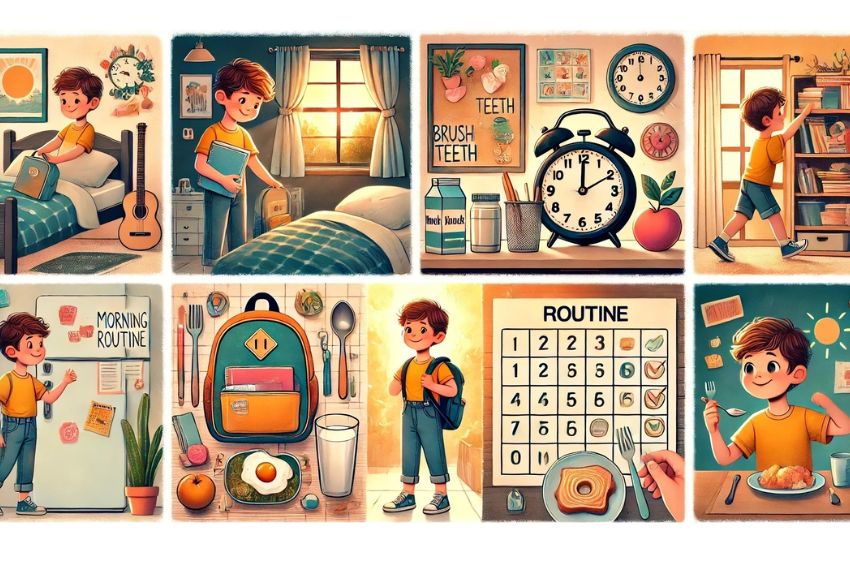Before and After School Routine : A Practical Guide
Getting kids ready for school in the morning and settling them down in the evening can be a daily challenge for many parents. Between finding shoes, packing lunches, and dealing with homework, it’s easy to feel overwhelmed. Evenings can bring more stress, with tired children, screen time battles, and rushed bedtimes all competing for attention.
That’s why having clear before and after school routine can make a real difference. A simple structure helps children feel secure, reduces stress, and makes your day run more smoothly.
In this blog, we’ll guide you through practical tips to set up both before and after school routine that actually work. From preparing the night before to managing homework.
Before and After School Routine – Why Routines Matter?
Routines aren’t just about keeping things organised, they shape how children grow, learn, and behave. A well planned routine gives children a clear structure, which helps them understand time, build self discipline, and manage their responsibilities.
Research shows that children who follow regular routines are more likely to develop strong habits and better emotional regulation. Simple things like doing homework at the same time each day or following a bedtime wind-down can lead to improved focus, fewer meltdowns, and better behaviour overall.
Routines also lay the groundwork for academic success. With a calm morning start and a steady after school plan, children are better rested, more prepared, and ready to learn.
For children with additional needs, such as autism, ADHD, or anxiety – routines are even more valuable. Predictability offers comfort and helps reduce feelings of uncertainty. When transitions are managed well, it becomes easier for them to cope with the demands of school and home life.
Morning Routine for School
Now that we understand why school routine or routines in general matter, let’s look at how to create a calm and productive start to the school day. A solid morning routine for school begins the night before and sets the tone for everything that follows.

Step 1 – Prepare the Night Before
Taking just 10-15 minutes in the evening can make your morning much easier. Lay out school clothes, pack bags, and prepare lunchboxes in advance. This avoids last-minute panic and frees up more time for a peaceful start.
Step 2 – Consistent Wake Up Times
Try to keep wake up times the same each day, even on weekends if possible. A regular sleep pattern helps children feel well rested and ready to go, making mornings less of a struggle. You can check the NHS guide on healthy sleep for children for age specific sleep recommendations.
Step 3 – Healthy Breakfast
Breakfast fuels the brain, so it’s important not to skip it. Keep things simple with quick, nutritious options like wholegrain toast, porridge, fruit, or yoghurt. Even a smoothie can do the trick on busy days.
Step 4 – Visual Schedules
For younger children, a visual checklist or routine chart can be very helpful. Pictures showing each step, like brushing teeth, getting dressed or eating breakfast. These make the routine easier to follow without constant reminders.
Step 5 – Time Management
You can use a timer or colour coded clock to keep things moving. These can easily help children understand how much time they have left and reduce morning delays. You can also use tools like Notion to plan the morning schedule, especially if your child prefers using digital checklists.
What Is The Best After School Routine?
Just as a strong morning routine sets children up for the day, a calm after school routine helps them wind down and recharge. After a full day at school, children need a balance of rest, focus, and connection to feel supported at home.
Tip 1 – Snack and Relaxation
Start with a healthy snack for their energy. Options like fruit slices, crackers with cheese, or yoghurt work well. Pair this with some quiet time, it could be – reading a book, listening to music, or just chatting about their day can help them switch gears.
Tip 2 – Homework Time
Set aside a regular time and place for homework. A quiet corner with minimal distractions helps them for better focus. Try to be nearby for support, but let them take the lead where possible to build independence.
Tip 3 – Chores and Responsibilities
Including small, age appropriate chores in the routine teaches responsibility. Simple tasks like setting the table, watering plants, or tidying up toys give children a sense of ownership and purpose.

Tip 4 – Free Play and Activities
Make space for unstructured play or creative activities. Whether it’s drawing, building with blocks, or spending time outdoors, play is a must for emotional development and stress relief.
Tip 5 – Dinner and Family Time
Whenever possible, aim for a shared meal. Dinner time is a great way to connect, talk about the day, and reinforce healthy habits. It doesn’t need to be fancy, just consistent.
Tip 6 – Bedtime Preparation
Wind things down with a clear bedtime routine. Warm baths, dim lights, and story time all help signal that it’s time to sleep. Keeping this routine steady makes bedtime smoother and supports better rest.
What To Do When Your Child Resists The Routine?
Even with the best routine in place, some days your child just won’t want to follow it and that’s completely normal. When this happens, stay calm and avoid turning it into a power struggle. Try to understand what’s causing the resistance: Are they tired? Feeling rushed? Wanting more attention?
You can often ease the tension by offering small choices. For example, let them pick between two breakfast options or decide whether to do homework before or after their snack. Giving them a sense of control can make them feel more involved and less resistant.
Also, remind them gently why the routine helps “When we do it this way, we have more time to play later.” Consistency, patience, and empathy go a long way in helping children adjust.
Before and After School Routine : What Are Some Tips for Success?
Even with the best intentions, routines can fall apart from time to time and that’s perfectly normal. What matters most is staying flexible and not stressing over the occasional off day. Life happens, and routines should be able to bend when needed. At the same time, involving your child in planning the routine can make a big difference. Letting them choose between two snack options or decide the order of their tasks gives them a sense of control and makes them more likely to stick with it.
Consistency is also key. While weekends may feel more relaxed, keeping certain parts of the routine like wake up times or bedtime rituals, helps children feel grounded. And don’t forget the power of praise. A simple “Well done!” for remembering their school bag or brushing their teeth on time can be more motivating than you’d think.
Conclusion
Creating effective before and after school routine doesn’t have to be complicated. With a bit of planning and consistency, you can turn stressful mornings and chaotic evenings into calm, manageable parts of the day. We’ve looked at how routines support children’s behaviour, learning, and emotional wellbeing and how simple steps like prepping the night before, setting regular sleep times, and encouraging independence can make a big difference.
And if homework time ever becomes a real struggle, don’t hesitate to ask for support. For example, online tutors can take the pressure off and give your child the extra help they need, all from the comfort of home.
You Might Be Interested In
6 Things You Need to Know If Your Child Needs Help with Homework
How to Help My Child with School?








